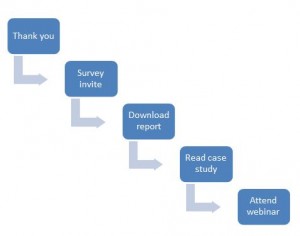It’s where most lead generation programs fail.
 It seems so odd in a way. You spend all this money generating a sales lead – some leads can cost upwards of $50-$100 apiece – and then you just turn it over to the sales force.
It seems so odd in a way. You spend all this money generating a sales lead – some leads can cost upwards of $50-$100 apiece – and then you just turn it over to the sales force.
Problem is there’s generally very little follow-up by marketing and very little accountability from sales.
I can only guess how many sales were never made – and how much lead generation money was lost – simply because marketing and sales didn’t stay in touch.
So what can be done? What should be done?
Start with Lead Qualification
You still want to turn the lead over to sales, but you might want to think about your timing. Are these leads ready for a follow up call or visit from your sales team? Are they worth your time at this point?
Instead of just handing the leads over to sales, would it make more sense to make a qualifying telephone call?
Sales people are human too – and if too many of your sales leads are found to be unqualified, they will begin to pre-judge the leads without even a phone call. You need to keep your sales team fully engaged and enthusiastic about your program.
Then move to Lead Nurturing. Today it’s easier than ever.
The reality is that most of your leads will not be sales-ready on the first follow-up call.
That doesn’t mean they are not good prospects down the road. But you don’t want to leave those prospects with sales. It’s too early. You want to cultivate those leads through marketing and then turn them over when there is a better time
Ideally, marketing and sales should work together. But experience tells that doesn’t happen very often.
At the very least, marketing should have a follow-up contact plan in place – using email and direct mail – and should keep sales informed of the schedule and any additional qualifying responses that might come in as a result of that effort.
Email is the medium of choice these days for follow-up. It’s fast, easy and inexpensive. (Just be sure the prospect voluntarily gives you his/her email address as part of the response.)
I still recommend direct mail as a follow-up medium, but less so now that email has become an acceptable form of marketing communications.
Content (for both email and direct mail) will vary depending upon the product or service.
A series of short articles focusing on different product features or benefits is one option.
Another is a series of case studies or customer testimonials.
If your product or service needs explanation, you might want to try a series of Q&A emails or application stories (how your product works in various applications).
Periodically, you might try a quick survey or questionnaire to assess where the prospect is in the buying/selling process.
Frequency is key. An email once a week (after the prospect has initiated an inquiry) is not too intrusive. (When you compare that with the daily emails you get from some marketers, your once-a-week email will barely be noticed.)
After a couple of months, you might want to spread out your emails for those prospects who are still unwilling to move to the next step. On the other hand, if your prospects are able to tell you when they might be making a buying decision, you could hold off on the intense email schedule until that time period.
Whatever method of contact you use – email, direct mail or the telephone – the goal is to get the prospect to say “Yes, I’m ready to talk to a sales person.”
But everyone’s schedule is different – so stay in touch.
———-
Written by Bob McCarthy
This article may be reprinted without permission as long as the article includes the following credit: Bob McCarthy is a freelance copywriter and consultant specializing
- A High-Wire Act for Today’s Marketers - January 28, 2021
- Is it content – or just copy? - May 26, 2020
- How you can – and why you should – use your website to teach - May 12, 2020
- How to Generate Qualified Leads with Lead Surveys - March 1, 2020
- Gaps in your Email Schedule – and how to avoid them - September 4, 2019
- The Dizzying World of Letter Mail - July 22, 2019
- Do you have an Information Kit? - June 25, 2019
- Direct Mail and Those Pesky Millennials - November 8, 2017
- Landing Pages: Do you need a squeeze page or sales page – or both? - May 31, 2017
- Do you have the patience for content and inbound marketing? - May 6, 2017

